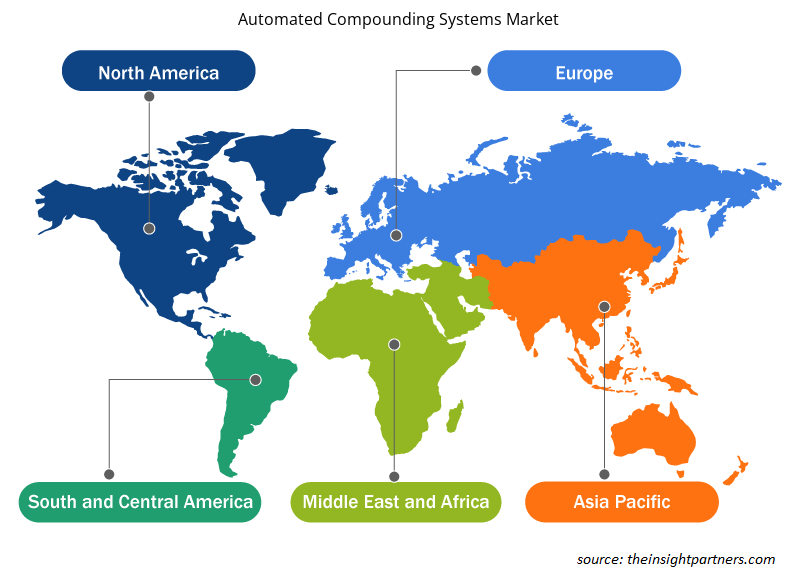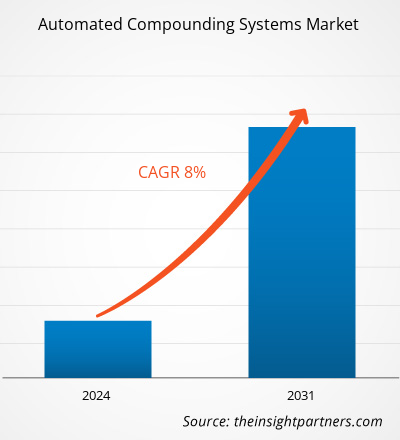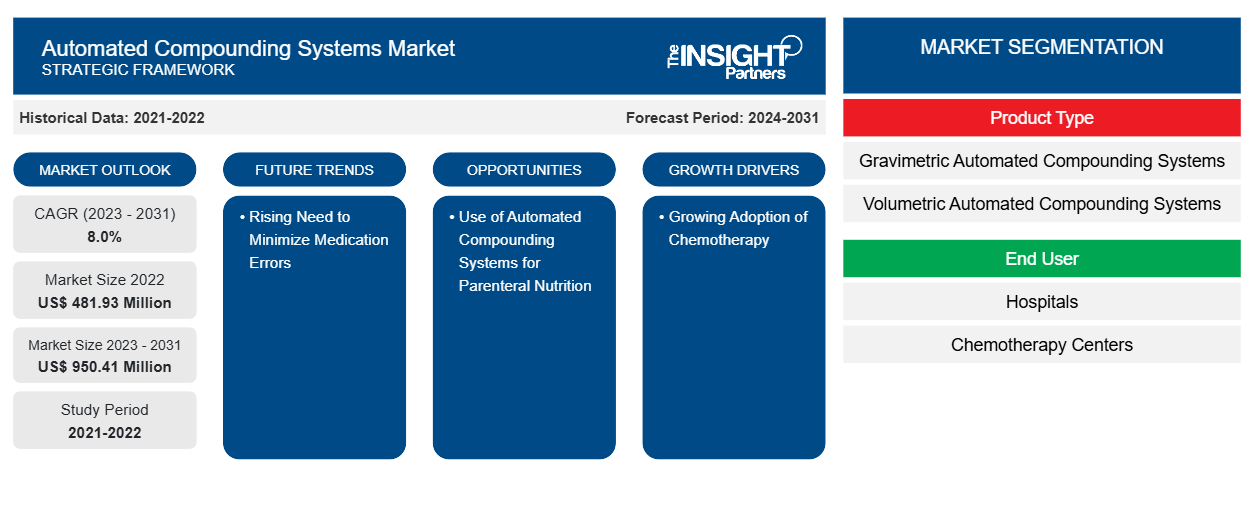Die Größe des Marktes für automatisierte Compounding-Systeme wurde auf 481,93 Millionen US-Dollar im Jahr 2022 und XX Millionen US-Dollar im Jahr 2023 geschätzt und soll bis 2031 950,41 Millionen US-Dollar erreichen; bis 2031 wird eine durchschnittliche jährliche Wachstumsrate (CAGR) von 8,0 % erwartet. Strategische Entwicklungen und Produkteinführungen werden voraussichtlich weiterhin wichtige Trends auf dem Markt für automatisierte Compounding-Systeme bleiben.CAGR of 8.0% till 2031. Strategic developments and product launches are likely to remain key Automated Compounding Systems Market trends.
Marktanalyse für automatisierte Compounding-Systeme
Die steigende Nachfrage nach personalisierten Medikamenten, verbesserte Patientensicherheit, strenge Vorschriften für die Arzneimittelherstellung, die Effizienz und Kosteneffizienz automatisierter Herstellungssysteme und das zunehmende Bewusstsein der Apotheker treiben das Wachstum des Marktes für automatisierte Herstellungssysteme voran. Darüber hinaus hat die zunehmende Verbreitung chronischer Krankheiten die Nachfrage nach automatisierten Herstellungssystemen angekurbelt.
Marktübersicht für automatisierte Compounding-Systeme
Automatisierte Mischsysteme helfen, Medikationsfehler zu vermeiden, die durch verschiedene Faktoren verursacht werden, wie etwa schlechte Kommunikation zwischen Arzt und Apotheker, kritische Lagerungspraktiken in Apotheken und Verwirrung, die durch die Verwendung ähnlicher Etiketten entsteht. Darüber hinaus haben sich mit den automatisierten Mischsystemen die Genauigkeit und Effizienz der Abgabe von Mischprodukten verbessert und die Belastung des medizinischen Personals mit toxischen Substanzen weiter reduziert.
Passen Sie diesen Bericht Ihren Anforderungen an
Sie erhalten kostenlos individuelle Anpassungen an jedem Bericht, einschließlich Teilen dieses Berichts oder einer Analyse auf Länderebene, eines Excel-Datenpakets sowie tolle Angebote und Rabatte für Start-ups und Universitäten.
- Holen Sie sich die wichtigsten Markttrends aus diesem Bericht.Dieses KOSTENLOSE Beispiel umfasst eine Datenanalyse von Markttrends bis hin zu Schätzungen und Prognosen.
Markttreiber und Chancen für automatisierte Compounding-Systeme
Steigender Bedarf zur Minimierung von Medikationsfehlern
Medikations- und Abgabefehler sind weltweit die Hauptursachen für Krankenhauswiederaufnahmen. Medikationsfehler können sowohl von medizinischem als auch von paramedizinischem Personal auf zahlreichen Ebenen der Patientenversorgung begangen werden. Ein Medikationsfehler kann aufgrund verschiedener Faktoren auftreten, beispielsweise aufgrund einer schlechten Kommunikation zwischen Arzt und Apotheker, gefährlicher Lagerungspraktiken in Apotheken und Missverständnissen aufgrund der Verwendung derselben Etiketten. Daher ist eine mehrstufige Überwachung obligatorisch. Automatisierte Mischsysteme gelten als eine der geeignetsten Lösungen zur Verringerung dieser Fehler. Verschiedene Regierungsorganisationen arbeiten an Maßnahmen zur Vermeidung von Medikationsfehlern und entwickeln Methoden und Systeme zur Überwindung dieser Fehler, um den Patienten die richtigen Medikamente zu geben. Um Medikations- und Mischfehler zu minimieren, fördern Regierungen in mehreren Ländern den Einsatz automatisierter Misch- und Medikationswerkzeuge in Apotheken und Krankenhäusern. Dies gilt als ein wichtiger Faktor, der das Wachstum des Marktes für automatisierte Mischsysteme vorantreibt.readmissions across the world. Medication errors can happen by both medical and paramedical personnel at numerous levels of patient care. A medication error can happen due to several factors such as poor order communication between the doctor and pharmacist, hazardous storage practices in drugstores, and misunderstanding raised due to the usage of the same labels. Hence, multilevel monitoring is compulsory. Automated compounding systems are deliberated to be one of the most qualified solutions to diminish these errors. Various government organizations are working on the measures to avoid medication errors and developing methods and systems to overcome these errors in order to provide proper medication to the patients. Thus, to minimize medication and compounding errors, governments in several nations are encouraging the use of automated compounding and medication tools in pharmacies and hospitals. This is considered to be a major factor propelling the growth of automated compounding systems market.
Einsatz automatisierter Compounding-Systeme für die parenterale Ernährung – eine Chance für den Markt für automatisierte Compounding-SystemeParenteral Nutrition – An Opportunity of Automated Compounding Systems Market
Parenterale Ernährung ist angezeigt, wenn Patienten aufgrund von Krankheiten wie Krebs und chronischen Erkrankungen des Magen-Darm-Trakts ihren nutrition is indicated when patients cannot meet their Nährstoffbedarf nicht decken können . Diese Art der Ernährung ist der Eckpfeiler der Therapie für die meisten Patienten mit schwerem Kurzdarmsyndrom (SBS). SBS tritt jährlich bei etwa 3 von 1 Million Menschen auf. Laut dem 2020 veröffentlichten Artikel „Understanding Short Bowel Syndrome: Current Status and Future Perspectives“ hat sich die Prävalenz von SBS in den letzten 40 Jahren mehr als verdoppelt. Die Prävalenz betrug in den USA etwa 30 Fälle pro Million und in Europa etwa 1,4 Fälle pro Million. Zur Herstellung von parenteralen Ernährungsprodukten können automatisierte Mischsysteme verwendet werden. Die automatisierten Mischsysteme sind normalerweise mit einer speziellen Software verbunden, die Informationen über PN-Formulierungen elektronisch überträgt. Eine Reihe von Forschern vergleichen die PN-Formulierungen, die mit automatisierten Mischsystemen und mit manuellen Methoden hergestellt wurden. Die laufenden Forschungen zur Verwendung automatisierter Mischsysteme zur Formulierung von PN werden voraussichtlich Wachstumschancen für den Markt für automatisierte Mischsysteme schaffen.SBS). SBS occurs in ~3 per 1 million people yearly. As per the article titled “Understanding Short Bowel Syndrome: Current Status and Future Perspectives," published in 2020, the prevalence of SBS has increased by more than twofold in the last 40 years. The prevalence was ~30 cases per million in the US and approximately 1.4 cases per million in Europe. Automated compounding systems can be used to manufacture parenteral nutrition products. The automated compounding systems is usually linked to dedicated software that electronically transfers information about PN formulations. A number of researchers are comparing the PN formulations prepared by automated compounding systems and by manual methods. The ongoing researches for use of automated compounding systems for formulation of PN is expected to create opportunity for growth of automated compounding systems market.
Segmentierungsanalyse des Marktberichts für automatisierte Compounding-Systeme
Wichtige Segmente, die zur Ableitung der Marktanalyse für automatisierte Compounding-Systeme beigetragen haben, sind Verabreichungsweg, Anwendung und Endbenutzer.
- Basierend auf dem Produkttyp ist der Markt für automatisierte Compounding-Systeme in gravimetrische automatisierte Compounding-Systeme und volumetrische automatisierte Compounding-Systeme unterteilt. Das Segment der gravimetrischen automatisierten Compounding-Systeme hatte im Jahr 2023 den größten Marktanteil.
- Nach Endbenutzer ist der Markt für automatisierte Compounding-Systeme in Krankenhäuser, Chemotherapiezentren und andere unterteilt. Das Krankenhaussegment hatte im Jahr 2023 den größten Marktanteil.
Automatisierte Compounding-Systeme Marktanteilsanalyse nach Geografie
Der geografische Umfang des Marktberichts über automatisierte Compounding-Systeme ist hauptsächlich in fünf Regionen unterteilt: Nordamerika, Asien-Pazifik, Europa, Naher Osten und Afrika sowie Süd- und Mittelamerika.
Nordamerika dominiert den Markt für automatisierte Compounding-Systeme. Das Marktwachstum in Nordamerika ist gekennzeichnet durch eine erhöhte Nachfrage nach Medikamenten gegen chronische Krankheiten, die Präsenz wichtiger Marktteilnehmer, eine Zunahme von Produkteinführungen, die zunehmende Einführung automatisierter Compounding-Systeme in den USA, eine steigende Arzneimittelproduktion, die zu einer steigenden Nachfrage nach automatisierter Abfüllung und Verpackung von Arzneimitteln führt, sowie umfangreiche F&E-Aktivitäten von akademischen und Forschungsinstituten und Pharmaunternehmen. Darüber hinaus wird erwartet, dass der asiatisch-pazifische Raum in den kommenden Jahren die höchste durchschnittliche jährliche Wachstumsrate verzeichnen wird.
Regionale Einblicke in den Markt für automatisierte Compounding-Systeme
Die regionalen Trends und Faktoren, die den Markt für automatisierte Compounding-Systeme während des gesamten Prognosezeitraums beeinflussen, wurden von den Analysten von Insight Partners ausführlich erläutert. In diesem Abschnitt werden auch die Marktsegmente und die Geografie für automatisierte Compounding-Systeme in Nordamerika, Europa, im asiatisch-pazifischen Raum, im Nahen Osten und Afrika sowie in Süd- und Mittelamerika erörtert.

- Erhalten Sie regionale Daten zum Markt für automatisierte Compounding-Systeme
Umfang des Marktberichts zu automatisierten Compounding-Systemen
| Berichtsattribut | Details |
|---|---|
| Marktgröße im Jahr 2022 | 481,93 Millionen US-Dollar |
| Marktgröße bis 2031 | 950,41 Millionen US-Dollar |
| Globale CAGR (2023 - 2031) | 8,0 % |
| Historische Daten | 2021-2022 |
| Prognosezeitraum | 2024–2031 |
| Abgedeckte Segmente | Nach Produkttyp
|
| Abgedeckte Regionen und Länder | Nordamerika
|
| Marktführer und wichtige Unternehmensprofile |
|
Dichte der Marktteilnehmer für automatisierte Compounding-Systeme: Auswirkungen auf die Geschäftsdynamik verstehen
Der Markt für automatisierte Compounding-Systeme wächst rasant, angetrieben durch die steigende Nachfrage der Endnutzer aufgrund von Faktoren wie sich entwickelnden Verbraucherpräferenzen, technologischen Fortschritten und einem größeren Bewusstsein für die Vorteile des Produkts. Mit steigender Nachfrage erweitern Unternehmen ihr Angebot, entwickeln Innovationen, um die Bedürfnisse der Verbraucher zu erfüllen, und nutzen neue Trends, was das Marktwachstum weiter ankurbelt.
Die Marktteilnehmerdichte bezieht sich auf die Verteilung der Firmen oder Unternehmen, die in einem bestimmten Markt oder einer bestimmten Branche tätig sind. Sie gibt an, wie viele Wettbewerber (Marktteilnehmer) in einem bestimmten Marktraum im Verhältnis zu seiner Größe oder seinem gesamten Marktwert präsent sind.
Die wichtigsten auf dem Markt für automatisierte Compounding-Systeme tätigen Unternehmen sind:
- Simplvia
- Baxter International Inc.
- Braun Melsungen AG
- Komm schon
- ICU MEDICAL INC
- Grifols, SA
Haftungsausschluss : Die oben aufgeführten Unternehmen sind nicht in einer bestimmten Reihenfolge aufgeführt.

- Erhalten Sie einen Überblick über die wichtigsten Akteure auf dem Markt für automatisierte Compounding-Systeme
Marktnachrichten und aktuelle Entwicklungen zu automatisierten Compounding-Systemen
Der Markt für automatisierte Compounding-Systeme wird durch die Erfassung qualitativer und quantitativer Daten nach Primär- und Sekundärforschung bewertet, die wichtige Unternehmensveröffentlichungen, Verbandsdaten und Datenbanken umfasst. Im Folgenden finden Sie eine Liste der Entwicklungen auf dem Markt für automatisierte Compounding-Systeme und -Strategien:
- Simplivia hat die innovative Chemo-Automatisierungslösung SmartCompounders auf den Markt gebracht, die auf dem führenden Chemfort Closed System Drug-Transfer Device (CSTD) basiert. Sie gibt Apothekern und Technikern die Werkzeuge an die Hand, um den Compounding-Prozess kürzer und zuverlässiger zu gestalten und Fehler bei der Medikamentenidentifikation und Dosierungsmenge auszuschließen. (Quelle: Simplivia, Unternehmenswebsite, 2024)
- Baxter International Inc hat den ExactaMix Pro Automated Compounder auf den Markt gebracht. ExactaMix Pro kombiniert im Vergleich zu ExactaMix verbesserte Sicherheit mit intuitiveren und effizienteren Funktionen und einer höheren Verarbeitungsleistung. (Quelle: Baxter, Unternehmenswebsite, 2022)
Marktbericht zu automatisierten Compounding-Systemen – Umfang und Ergebnisse
Der Bericht „Marktgröße und Prognose für automatisierte Compounding-Systeme (2021–2031)“ bietet eine detaillierte Analyse des Marktes, die die folgenden Bereiche abdeckt:
- Marktgröße und Prognose auf globaler, regionaler und Länderebene für alle wichtigen Marktsegmente, die im Rahmen des Projekts abgedeckt sind
- Marktdynamik wie Treiber, Beschränkungen und wichtige Chancen
- Wichtige Zukunftstrends
- Detaillierte PEST/Porters Five Forces- und SWOT-Analyse
- Globale und regionale Marktanalyse mit wichtigen Markttrends, wichtigen Akteuren, Vorschriften und aktuellen Marktentwicklungen
- Branchenlandschaft und Wettbewerbsanalyse, einschließlich Marktkonzentration, Heatmap-Analyse, prominenten Akteuren und aktuellen Entwicklungen
- Detaillierte Firmenprofile
- Historische Analyse (2 Jahre), Basisjahr, Prognose (7 Jahre) mit CAGR
- PEST- und SWOT-Analyse
- Marktgröße Wert/Volumen – Global, Regional, Land
- Branchen- und Wettbewerbslandschaft
- Excel-Datensatz
Aktuelle Berichte
Erfahrungsberichte
Grund zum Kauf
- Fundierte Entscheidungsfindung
- Marktdynamik verstehen
- Wettbewerbsanalyse
- Kundeneinblicke
- Marktprognosen
- Risikominimierung
- Strategische Planung
- Investitionsbegründung
- Identifizierung neuer Märkte
- Verbesserung von Marketingstrategien
- Steigerung der Betriebseffizienz
- Anpassung an regulatorische Trends





















 Kostenlose Probe anfordern für - Markt für automatisierte Compounding-Systeme
Kostenlose Probe anfordern für - Markt für automatisierte Compounding-Systeme